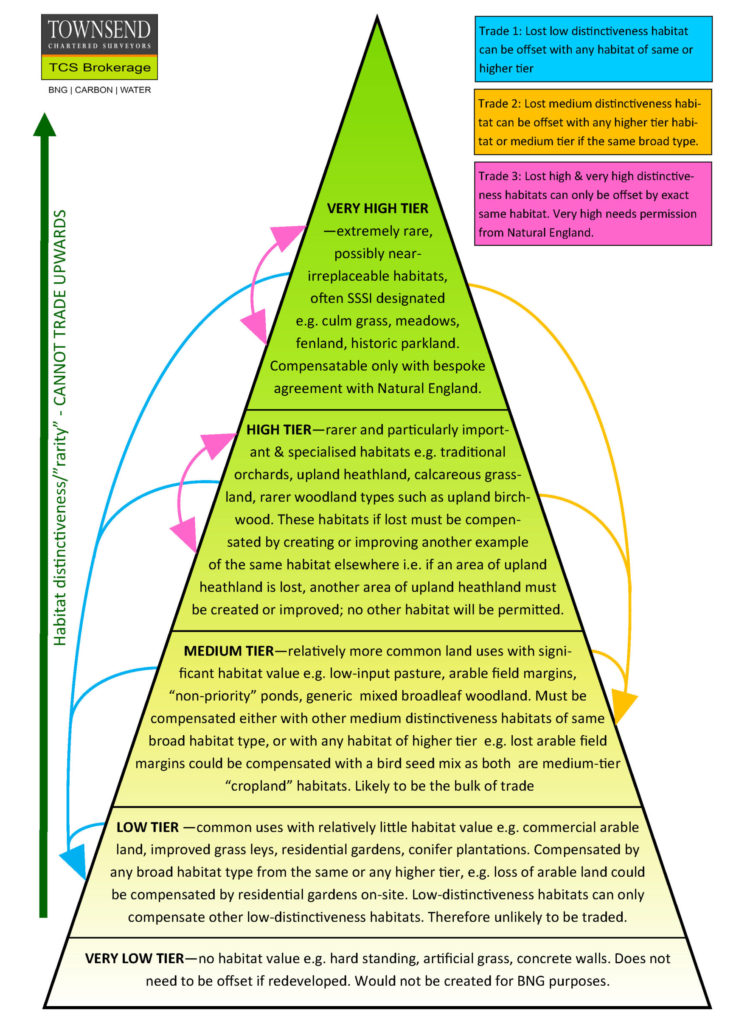1. INTRODUCTION
1.1 A common misunderstanding about the English Biodiversity Net Gain (BNG) market is that units can only be sold in their own Local Planning Authority (LPA) or the adjoining one. This confusion comes from two sources. The number of units sold outside their own LPA will be reduced by the “spatial risk multiplier” and developers must compensate lost units in the same LPA before they can buy units from elsewhere. If only these factors affected BNG, the market would resemble the Water Abstraction Licence market with hundreds of separate markets for each water catchment area.
1.2 However there are other factors meaning higher prices for BNG units can sometimes be achieved if they are marketed nationwide.
1.3 BNG represents the improvement in a habitat’s condition or the creation of new habitat to provide the equivalent of a 10% net gain in biodiversity. If this cannot be achieved on the development site then developers may pay farmers and landowners to improve their land, allowing developers to meet the upcoming statutory requirement affecting all developments requiring planning permission.
1.4 Comparing the different types of “net gain” is complex. Our Habitat distinctiveness/“rarity” Pyramid illustration should be read from the bottom up.

2. DEFINITIONS
2.1 Broad habitat type
This means the general category of land in question. There are 15 options for this, including woodlands, hedges, “cropland” (i.e. arable), grassland, urban, heathland, wetland, ponds, rivers and some rarer options such as “sparsely vegetated land” and “intertidal hard structures”.
2.2 Habitats
Land within a “broad habitat type” can be one of a number of “habitats” within the broad habitat type. For example, “grassland” as a broad habitat type includes, among other options, commercial ryegrass pasture (“modified grassland” in government language), semi-natural “lowland calcareous grassland”, and traditional hay meadows. Which habitat is on a piece of land is set by the plants growing there.
2.3 Distinctiveness
2.3.1 Habitats are split by “distinctiveness”, i.e. value and rarity. Distinctiveness has five tiers, each represented by a layer of the Pyramid. Lower distinctiveness habitats are worth fewer BNG units and are simpler to replace; higher distinctiveness habitats are worth more units and the procedure for replacing them is more complicated. Habitats of different levels of distinctiveness are tradeable in different ways.
2.3.2 There are two ways a landowner can earn BNG units. One is to improve the “condition” of existing habitats. We do not cover this “improvement” here.
2.3.3 Alternatively new habitats that are of higher distinctiveness than the existing habitat can be created. This means moving the land from a lower tier of the Pyramid to a higher one. Ceasing ploughing and spraying an intensive pasture so it becomes an “unimproved” pasture will move the land from the “low-distinctiveness” tier to “medium-distinctiveness”, which will create units to sell.
2.3.4 Cannot replace a lost habitat with a habitat of lower distinctiveness
A lost habitat can never be replaced by habitat of a lower tier. If even a few square feet of mixed woodland, a “medium-distinctiveness” habitat, was lost to a development, the developer could not go ahead even if they committed to turning, say, all of a 30ha disused power station into a commercial conifer plantation (ignoring any of the broadleaf and open space areas which are always included in modern commercial planting). This is because commercial conifers, while more distinctive than the disused power plant, are less distinctive than the lost mixed woodland, so cannot replace it regardless of how much area they cover. They would instead in this example need to arrange for the planting, or improvement, of another woodland of medium distinctiveness or higher.
3. THE PYRAMID TIERS
The tiers of the Pyramid from bottom to top are:
3.1 “Very low” distinctiveness
3.1.1 These are areas which the Government thinks have no biodiversity value whatsoever. Examples include AstroTurf, hardstanding and concreted areas. They have no value in terms of BNG credits.
3.1.2 These areas do not need to be compensated if they are lost when redeveloped. Creating these areas will not grant any biodiversity units.
3.2 “Low” distinctiveness
3.2.1 These are common land uses which the Government thinks have relatively little, but still some, value to wildlife. They usually represent land that is closely managed for the benefit of people living and working on it but also harbours some wildlife as an indirect result of this use. The most common are arable cropland, “improved” grassland (i.e. productive grassland that is frequently ploughed up, fertilised and/or reseeded), commercial timber plantations and residential gardens.
3.2.2 Farmers are unlikely to produce many of these units. Almost all agricultural land will be low distinctiveness at a minimum. The only way to create units of this habitat type would be something resembling taking up a hardstanding area and returning it to cropping.
3.2.3 When lost to a development, a low distinctiveness habitat must be compensated, but any other low distinctiveness habitat will do, regardless of what kind. Any higher distinctiveness habitat also works, and this will quickly be worth more units than what was lost as lower distinctiveness habitats are worth fewer credits.
3.3 “Medium” distinctiveness
3.3.1 These are relatively common habitats which are frequently easier to establish than the higher tiers, while still being very important to the nation’s wildlife. They are enormously varied, covering some unusual land uses such as coastal silt and “green rooves” in cities. The medium-distinctiveness habitats farmers are most likely to encounter include “Stewardship-style” areas on arable land such as buffer strips and wildflower margins, “unimproved” pasture containing no particular rare plant life, most wildlife ponds, and many areas of planted amenity woodland.
3.3.2 Turning low distinctiveness land into habitats of this tier is likely to be the most common way for farmers to earn BNG credits. Those who have already been part of a Stewardship scheme will be familiar with many of the relevant habitats, and actions such as digging a pond or reducing inputs on grassland can, with adequate planning, fit into a commercial farming operation.
3.3.3 Broad types
Medium distinctiveness habitats are split by broad type, as explained above. When medium distinctiveness land is lost to development, it must be replaced with either other medium-distinctiveness habitats of the same broad type, or any habitats of “high” or “very high” distinctiveness.
3.4 “High” distinctiveness
3.4.1 These rarer habitats are generally difficult to replace if lost. There are relatively few of these kinds of habitats affecting farmland. These include some relatively rarer woodland habitats; upland calcareous grassland and “tall grassland herb communities”; most open heathland; wetland reed beds; and many inland water features including reservoirs, lakes and more ecologically important wildlife ponds.
3.4.2 Most of these habitats are difficult for farmers to create, with the two grassland habitats in particular unlikely to be feasible (some very high distinctiveness grassland habitats are usually easier to establish). New woodlands could aim to be in this tier, and an ecologically important wildlife pond is something a farmer in a priority location could potentially create. A heathland farmer could create open heathland by sympathetic scrub clearance.
3.4.3 Replace with exact same habitat
Where a developer is building on a high distinctiveness habitat, they must replace it with the exact same habitat elsewhere. In other words, if they have somehow gained permission to fill in a high-priority wildlife pond as part of their development, they must ensure another such pond is created (or improved) elsewhere before they can proceed. It may be that for some habitats in this tier, very few credits are available as few farmers can create these habitats, so the credits could be very valuable indeed to a developer requiring them. However, biodiversity offset is in addition to, rather than in replacement of, other planning constraints. Developers may find it difficult to receive permission to build on them before BNG is even considered, especially as many of these kinds of habitats will be found on protected sites such as National Parks and SSSIs. They are also largely quite rare, meaning there are relatively few of them to develop on in the first place. Therefore, whilst supply of credits may be limited, demand may be limited even more. However, even if a farmer creating a high-distinctiveness habitat cannot find a buyer for that exact habitat, the higher distinctiveness means the farmer should have more credits to sell to developers of lower-distinctiveness habitats. These credits are more versatile because they are not limited to a single broad type of medium-distinctiveness habitat, likely making them more valuable. Farmers should consider creating them where possible.
3.5 “Very High” distinctiveness
3.5.1 These represent what are, in theory, the rarest and most valuable habitats in the country. They include highly specialised, e.g. “littoral seagrass on peatland” to the surprisingly familiar “meadows”. The latter includes traditional hay meadows which can conceivably be created, albeit with some effort, by a livestock farmer moving to a less extensive operation. “Wood pasture and parkland” and “traditional orchards” are also included and are relevant to farmers experimenting with agroforestry and many traditional estate. Other relevant habitats in this tier include lowland dry acid grass, purple moor grass (known in Devon as “Culm grass”) and all kinds of peatland.
3.5.2 Developers will require special permission from the Secretary of State before they can build on these kinds of habitats, which will require a specially tailored compensation strategy. This is likely to be prohibitive even to the largest private developers. However, it may arise in some national infrastructure projects. This means the market for these units is likely to be very small, but they will be extremely valuable to those requiring them. Note that because the tier below this, “high distinctiveness” requires like-for-like replacement, these credits can only be traded down for medium and low-distinctiveness offsetting. However, creation of these habitats has the potential to produce so many units that, once again, it is worth considering creating them where possible.
4. SUMMARY
4.1 Significant expertise will be needed to operate efficiently in the BNG market.
4.2 Developer demand for low distinctiveness (LD) credits will represent a floor price. Most credits farmers create will be medium distinctiveness (MD) of some kind. When there is no demand in their area for a specific type of MD credit, they can be sold on the LD market instead to receive some profit. If there was more demand than supply for all types of MD credit, the LD price should match whichever MD credit is cheapest.
4.3 MD credits will have their markets split by type. The most common, and most demanded, will be medium distinctiveness grassland (MDG) and medium distinctiveness arable (MDA). Farmers will find these credits easiest to produce, and developers are most likely to develop this kind of land. There will also be markets for medium distinctiveness heathland (MDH) in some parts of the country; medium distinctiveness water (MDWa) where a pond is to be filled in; and medium distinctiveness woodland (MDWo) mostly for infrastructure projects. Urban, intertidal and “sparsely vegetated” land will each have their own MD markets, but these will be relevant to fewer farmers. Those who farm along coastlines and estuaries, or in areas with exposed rock, should still take note nonetheless.
4.4 High distinctiveness (HD) and very high distinctiveness (VHD) will contain within them a “micromarket” for each specific habitat, with both buyers and sellers sometimes waiting for long periods for high value trades, much like the water abstraction licence market. Sellers in the top two tiers will frequently prefer to save themselves the time and complexity and sell their credits on the LD or the MD market instead. This may mean very rich rewards for those who wait!
4.5 Therefore marketing of BNG units should always be carried out nationally as distinctiveness can make units in one LPA that much more valuable than in another even accounting for the reduced number that can be sold.
A full version of this Fact Sheet is available here
To download/view article click here

